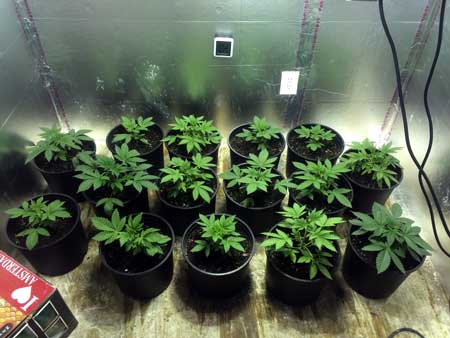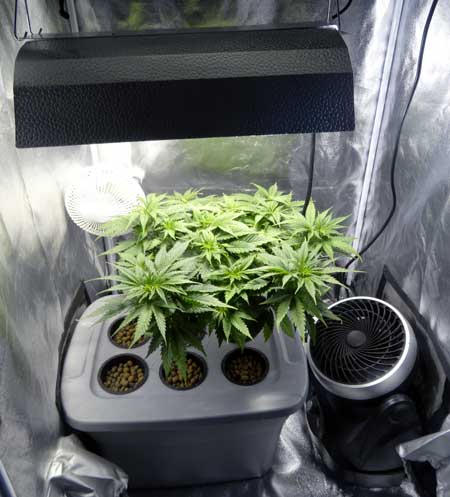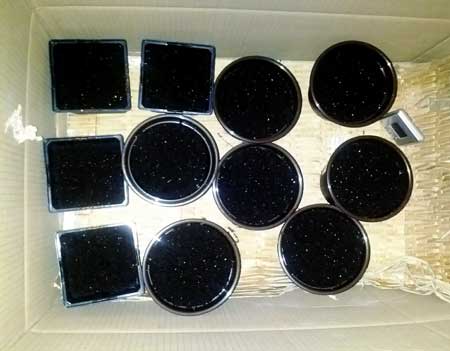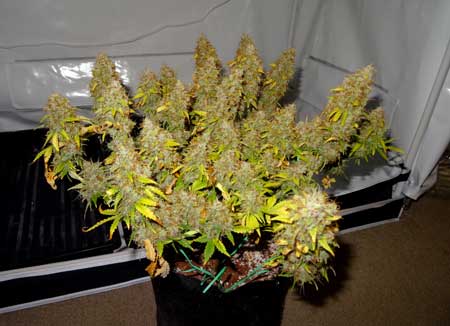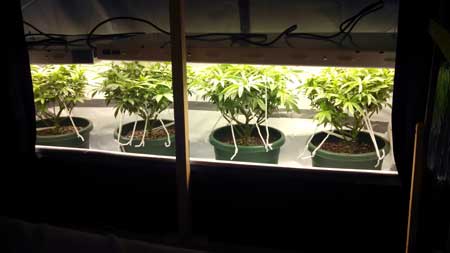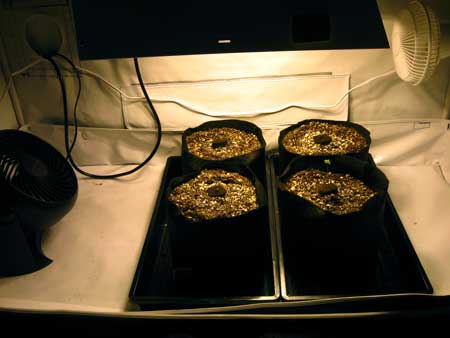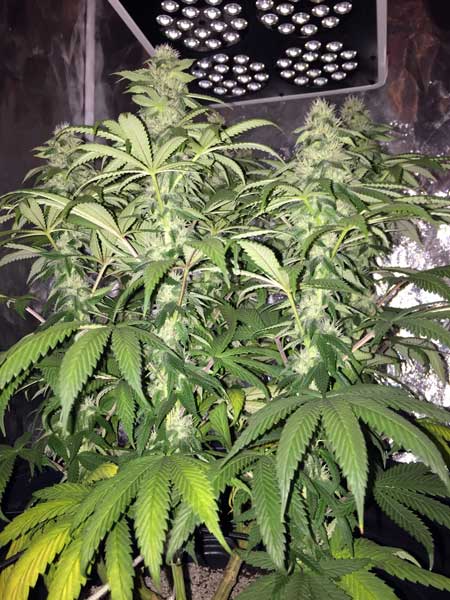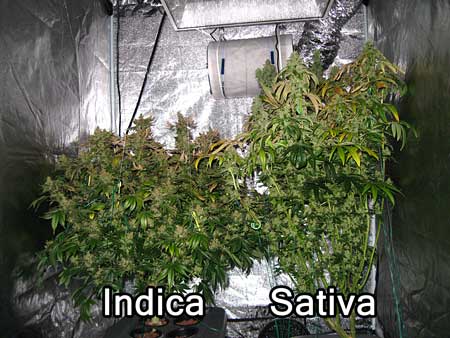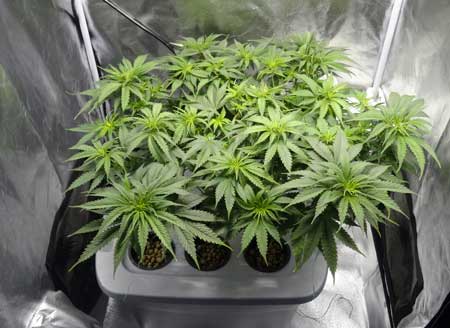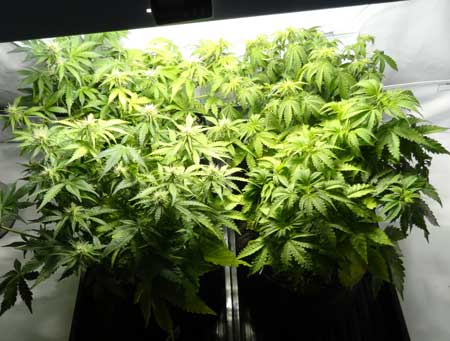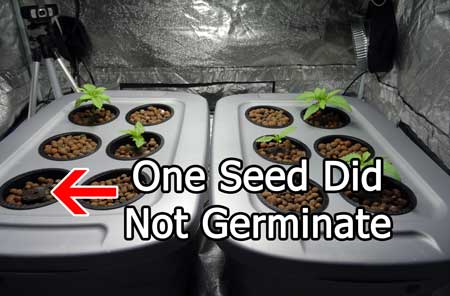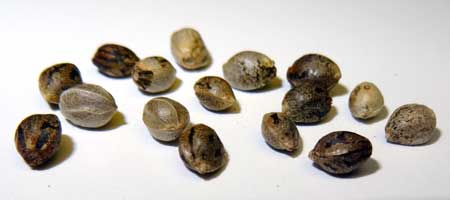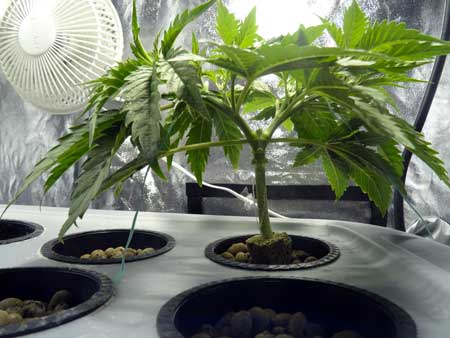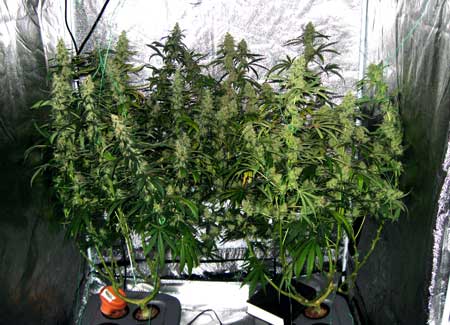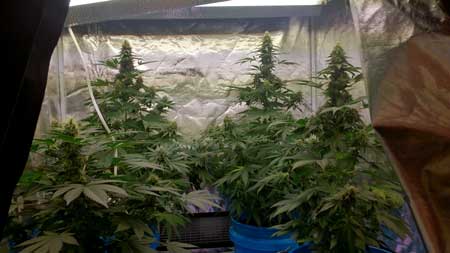by Nebula Haze
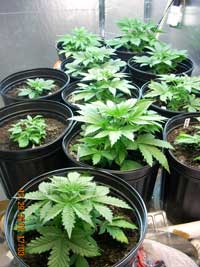
This is one of the most common questions I hear from new growers, and it’s great if you’re asking this question because it’s actually pretty important.
If you grow too many or too few plants, you may not get the yields you want, and it can possibly take longer than needed until you get to harvest. It’s a little bit of a balancing act of finding the right amount of plants to achieve your goals.
The short answer is that for one grow light, you should plan on growing 1-8 plants. If you grow more than 8 plants under a single grow light, chances are you’re hurting your yields by not giving each plant enough space to thrive.
Don’t grow more than 8 plants under a single grow light
In the following pic, there are too many plants to grow all the way to harvest under a single grow light – each plant won’t get enough light and space to produce a significant amount of dense bud. The small pot size needed to fit this many plants in a small space will also eventually stunt each plant even if they did get enough space and light. This grower would likely get bigger yields by growing fewer plants in bigger pots.
There are several factors that make a difference when it comes to how many cannabis plants you should grow including the size of your space and what grow lights you’re using. I’ll explain each factor so you can grow the perfect number of plants for your setup to maximize yields and harvest as soon as possible!
Factors to Consider
Size of grow space
Type/Size of containers
Grow light
Ease of growing
Yields
Desired timeline (How soon do you want to harvest?)
Size of Grow Space
The total size of your grow space affects the number of containers you can fit in your grow space. If you have small containers you will physically be able to fit more in your grow space than if you were using big containers. If you’re growing with extra big containers (for example a DWC reservoir) you may only be able to fit one or two plants in your grow space.
Because the DWC reservoir is large, there really isn’t enough room for another container in this grow tent
Type/Size of Containers
Going along with the size of your space, the size of your containers affects how big your plants will get. Smaller containers can support smaller plants, but if you want big plants you want big containers. Which size container? (full guide)
The max number of plants is determined by how many plant containers you can physically fit in your grow space
You will likely end up growing less plants than this max, but you won’t be able to grow more! Once you know what size container(s) you plan to use, you’ll be able to figure out the upper limit of how many can physically fit in your grow space.
As a general rule, for hand-watered plants if your final (desired) plant size is…
- 12″ ~ 2-3 gallon container
- 24″ ~ 3-5 gallon container
- 36″ ~ 5-7 gallon container
- 48″ ~ 6-10 gallon container
- 60″ ~ 8-10+ gallon container
Too-small pots can stunt plants and cause symptoms that look like nutrient deficiencies. Learn how to transplant plants to a bigger pot.
The space around each plant container needs to be big enough to support the desired plant size! Keep in mind that each plant is likely going to be bigger than the width of its container, and needs enough room to spread out!
Think about how big you want each plant to get, and leave enough room around each container to support the plant you want.
Grow Light Part 1 – Figure Out Your Light Footprint
The grow light you use determines your total available light coverage (how much space can actually support plants). If you have a small grow light, it will only have a small amount of coverage even in a big grow space. You can only grow vibrant plants within a grow light’s “light footprint” – where the plant is getting direct light.
Therefore the size of the light indirectly determines how much space you can use to grow plants. If desired, you can actually measure your light footprint directly by using a cheap lux meter. Or use the following general guidelines…
For CFLs & Other Fluorescents (like the T5), the light footprint includes only the space directly under the bulbs, as the light (usable by plants) from fluorescent lighting does not travel much further than a few inches. All parts of the plant should be within a foot of a bulb, otherwise they’ll be outside the light footprint. Therefore the total footprint depends on how you configure your CFLs or fluorescents.
CFLs or fluorescent grow lights should be kept just a few inches away from your plants
For MH/HPS, your light footprint is as follows:
- 150W – covers 2′ x 2′ (0.6m x 0.6m) area
- 250W – covers 2′ x 2′ (0.6m x 0.6m) area up to 2.5′ x 2.5′ (0.8m x 0.8m)
- 400W – covers 3′ x 3′ (0.9m x 0.9m) area up to 3.5′ x 3.5′ (1m x 1m)
- 600W – covers 3.5′ x 3.5′ (1m x 1m) area up to 4′ x 4′ (1.2m x 1.2m)
- 1000W – covers 4′ x 4′ (1.2m x 1.2m) area up to 5′ x 5′ (1.5m x 1.5m)
A 150W HPS grow light can cover up to a 2’x2′ area, so all the plants in this picture are getting good light levels. However, any plants outside that main area would be starved for light. You can actually see the corners of this tent are in shadow.
For LEDs, the light footprint is different depending on the model, and you can get this information from the manufacturer. Feel free to check out a short list of some cannabis-tested LED grow lights which includes their light footprint information.
The Kind “K3 L600” LED grow light (like the one pictured below) has a light footprint of 3’x4′. That means any plants growing inside that area under the lamp will be fine, but plants outside that footprint won’t be getting enough light.
Grow Light Part 2 – Make Sure There’s Enough Total Light Power for Each Plant
When it comes to the size of the grow light vs how many plants, you never want to give a plant less than 75W worth of light per plant for HPS/LED, and 150W per plant for CFL/T5. A plant that receives less light than this likely will never get big enough to produce a significant amount of bud, or buds will be airy. So make sure to consider the size of your light so you don’t grow more plants than your grow light can handle!
HPS/LED: At least 75W per plant
CFL/T5: At least 150W per plant
As an example, if you had a 400W HPS grow light, you use the formula this way: Take 400÷75=5.3. That means you probably shouldn’t grow more than 5 plants under a 400W HPS grow light.
If you had 400W worth of CFLs, you would take 400÷150=2.6. That means you really shouldn’t grow more than 2-3 plants under that many CFLs.
It’s important to keep in mind that these figures are bare minimums! For example, in my current setup each plant I grow gets 250W to itself, while Sirius’ plants get 300W per plant.
Desired Ease of Growing
The number of plants you grow affects the overall ease of growing. Ultimately, more plants generally means more work and effort. Plants often need to be watered and trained individually, plus if you have more than one row of plants it can be really difficult to tend to the plants that are all the way in the back.
Growing just one plant at a time is the easiest, but you end up only harvesting one strain. When you are growing lot of plants of different strains at once there’s more of a chance that some of the plants will grow very differently from the others, which can be frustrating. If one plant is 3x the height of all the others, it becomes much more difficult to give every plant what it needs!
If you choose different strains, you may be surprised at how differently they grow in the exact same environment!
When it comes to desired ease of growing, opt for fewer plants for an easier grow, and opt for more plants if you really want extra strains and/or are willing to spend the extra time it takes to watch over and tend to many plants at once.
Desired Timeline + Yields (How soon and how much do you want to harvest?)
The amount of yield you can achieve with a good grow is determined less by the number of plants and more by your strain, skill and grow light (learn more about what determines your yields). Generally for any strain you will get about the same total yields from one or many plants, just as long as you fill up the space under the grow light.
But the timeline (how long it takes until harvest) is partially determined by how many plants you choose to grow, and this indirectly affects your yields.
As an example, if you’re growing in a 3’x3′ space, it might take 8 weeks in the vegetative stage to get just one plant to completely fill up that space. A single plant needs enough time to grow big enough to support all the buds you want to harvest. If you switched to flowering earlier than that, it would ultimately hurt your yields because you’d be wasting some of the space under the light.
This single plant needed almost 8 weeks in the vegetative stage to get big enough to fill in most of the grow tent
But if you were growing 2 plants in the same setup, each one would only need to grow half the size in the vegetative stage to achieve the same amount of coverage under the light. This is because a single seedling has less leaf mass and simply can’t use as much light as two seedlings. Less wasted light = more total growth. If you were growing 4 plants, each one only need to grow 1/4 the size to achieve the same coverage in the vegetative stage.
This fact can be used to shorten your veg stage because whether you’re growing one plant or many, once you’ve achieved that coverage in the vegetative stage you’ll end up getting similar yields at harvest. In other words, with more plants you may need less time to fill up your available growing space, which can save you a few weeks of veg time, leading to a quicker harvest!
Together, these 4 plants have created a canopy that is a similar shape, length and width as the single plant above. This means the yields will be similar (if the light and strain are the same). However, they only needed 6 weeks in the vegetative stage to achieve this size (2 weeks less veg time than the single plant above) so were able to switch the flowering stage sooner.
Ultimately, growing more plants (up to a point) allows you to have a shorter vegetative stage since your grow space will fill up much more quickly. And a shorter vegetative stage ends up saving you electricity and time! That being said, for some growers a few extra weeks of veg time is worth the fact that you have to spend less time tending your plants every day.
So in some ways when it comes to timelines/yields and number of plants, it’s a matter of deciding how much personal time you want to put in to your grow on a regular basis vs how much time you are willing to wait to get to harvest. If growing several strains and getting to harvest as quickly as possible is most important to you, opt for more plants (up to 8 under each individual grow light). If you want a grow that’s easier and less time-consuming, opt for fewer plants.
Additional Tips
Start with More Plants Than You Plan To Grow
If it’s your first grow (and honestly in general) it’s a good idea to start with more plants than you need. This lets you choose the best plants of the bunch and not be stuck with any weaklings that just aren’t growing as well as the others. Plus you never know when a seed won’t germinate or come with some other problem like a bad mutation.
This grower started with 6 plants even though they only planned on growing out two. This way if there’s a weakling or one of the seeds doesn’t germinate, it doesn’t affect your grow!
Start with Feminized Seeds
With non-feminized seeds, about half of your plants will end up being male (which need to be thrown away) and that can seriously mess with your plant numbers. To make things worse, due to the random nature of genetics sometimes you can end up with something like 5 males and 1 female out of six seeds (just as you can get 5 females and 1 male). This can make it hard to plan for the number of plants, because on average you would expect to get 3 females from 6 non-feminized seeds.
To make things a LOT easier for you as far as plant numbers, choose to start with feminized seeds (available for most strains). With feminized seeds, all your plants will end up being bud-bearing female plants, which means you get to keep all your plants.
Get feminized seeds from a trusted breeder
Maximize Yields by Filling Up Your Grow Space via Plant Training
The best yields indoors are achieved by using plant training to force cannabis plants to grow flat and wide. This is true for just about every indoor growing setup that uses grow lights. Plant training lets you fill up the entire space under your grow light with an even canopy of colas, and this can increase yields up to 40% compared to not training at all. Plus it’s free! If you don’t want to learn any new techniques but still want all the benefits, check out our page on no-technique plant training.
Example of the manifolding technique in action, which is a specific way to train the plant in the early vegetative stage to create multiple big colas instead of just one.
Ultimately, no matter what technique you use (or even if you use our no-technique plant training) your goal is to to grow a plant with many main buds like this.
When a plant is not trained, it only produces one main bud per plant. You don’t want this! It will reduce your overall yields indoors because only the single bud closest to the light will get big and fat. You want many main buds to get the most from your grow lights, and the best way to accomplish that is with plant training!
Learn more about plant training to increase yields under grow lights
Now that you know how many cannabis plants you want to grow, time to start growing!
New Growers Start Here
Complete Grower’s Shopping List
Common New Grower Topics
How Much Will Electricity Cost?
What Type of Nutrients Should I Use?
How Do I Choose the Best Grow Light?
Stealth Growing: How NOT to Get Caught Growing Weed

